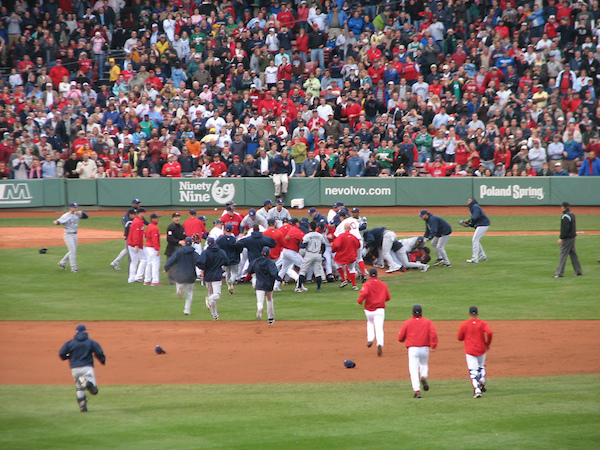Dear Sports Fan,
In relation to the inquiry “Why aren’t the Rules the Rules?“, what is your take on the series of conduct breaches in the recent Angels/Tigers skirmish? Everyone seems to be making a big stink about baseball’s “code of unwritten rules” and how a number of them were violated (and enforced) in the game: lingering at plate after hitting a home run; trash talking; spoiling a no-hitter with a bunt; intentionally pitching a fast ball at the batter’s head (okay that may be a real violation for which the pitcher was suspended). If this is unsportsmanlike conduct, then why aren’t there written rules to prevent such behavior? Why has the Angels/Tigers’ pissing match of retribution been defended by the players and coaches and justified by some MLB commentators after the fact? And if a pitcher is an inning away from a no-hitter, is the opposing team really supposed to just hand him the game?
Thanks,
Andrew Young
Dear Andrew,
This is a bit dated now because the game you mention was several weeks ago, but the question, at least in baseball, is always timely. Baseball fans and writers love talking and writing about the unwritten rules of their sport. That’s true for hockey too – both of them have a tradition of self-enforcement of an unwritten “code” which, as Geoffrey Rush would say, are more like “guidelines” anyway. There aren’t written rules about these things because they’re too subjective – ie, how can you tell whether a pitcher definitely threw at a hitter, how can you tell that a player bunted for a base hit to break up a no-hitter and not just because it was the only way his team could get on base?
That’s where the code comes in.
The code, in both baseball and hockey, has to do with two things: respect for your opponent and, therefore, the game, and policing dangerous play. In the game you reference, the two went hand in hand.
But, as in all things, context matters. You generally shouldn’t bunt to break up a no-hitter, but only if it’s blatant that you’re doing it to break up a no-hitter – ie, if you’re losing by enough that you’d enforce a mercy rule if it were little league, or you haven’t bunted since the first Bush Administration. If you’re down by three and known as a speedy guy who sometimes actually bunts to get on base, you can usually get away with it.
It’s acceptable to throw at a hitter if the opposing team’s pitcher did the same to one of your teammates – but it’s never ok to throw at the head.
The code is pretty clear that you finish your home run trot in a timely fashion and don’t stand there admiring it, but who’s to say what’s timely? Staring down the pitcher after you hit a home run – as happened in this case – is a clear no-no.
When all of these self-enforcement mechanisms fail, baseball resorts to the ultimate in phony tough guy moments: the bench-clearing brawl. Baseball is different than hockey cause when hockey players brawl, you can tell it’s a brawl. For instance, they actually make physical contact with people. When baseball players brawl, it’s like a swarm of electrons meeting at midfield. They get really really close but 99 percent of the time they move away before there’s any actual contact. If someone actually lands a punch, it’s news – if a 70 year old bench coach is tossed on his ass by a 35 year old athlete it’s a clip that will be replayed for decades.
So while there are some legitimate reasons for these rules to exist – namely, helping people protect their teammates – these unwritten rules are really just another way for athletes, the reporters who cover them and the commentators who commentate on them (who are frequently former athletes) to make clear that they’re a part of a unique group of people who have their own special rules that other people just can’t understand.
Thanks,
Dean Russell Bell

